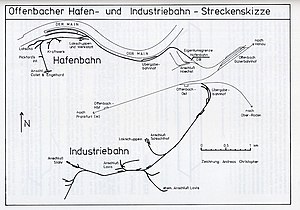Offenbach industrial railway
| Offenbach industrial railway | |||||||||||||||||||||||||||||||||||||||||||||||||||||||||||||||||||||||||||||||||||||||||||||||||||||||||||||||||||||||||||||||||||||||||
|---|---|---|---|---|---|---|---|---|---|---|---|---|---|---|---|---|---|---|---|---|---|---|---|---|---|---|---|---|---|---|---|---|---|---|---|---|---|---|---|---|---|---|---|---|---|---|---|---|---|---|---|---|---|---|---|---|---|---|---|---|---|---|---|---|---|---|---|---|---|---|---|---|---|---|---|---|---|---|---|---|---|---|---|---|---|---|---|---|---|---|---|---|---|---|---|---|---|---|---|---|---|---|---|---|---|---|---|---|---|---|---|---|---|---|---|---|---|---|---|---|---|---|---|---|---|---|---|---|---|---|---|---|---|---|---|---|---|
|
Location of the industrial railway
| |||||||||||||||||||||||||||||||||||||||||||||||||||||||||||||||||||||||||||||||||||||||||||||||||||||||||||||||||||||||||||||||||||||||||
| Route length: | 4.3 km | ||||||||||||||||||||||||||||||||||||||||||||||||||||||||||||||||||||||||||||||||||||||||||||||||||||||||||||||||||||||||||||||||||||||||
| Gauge : | 1435 mm ( standard gauge ) | ||||||||||||||||||||||||||||||||||||||||||||||||||||||||||||||||||||||||||||||||||||||||||||||||||||||||||||||||||||||||||||||||||||||||
|
|||||||||||||||||||||||||||||||||||||||||||||||||||||||||||||||||||||||||||||||||||||||||||||||||||||||||||||||||||||||||||||||||||||||||
The Offenbach industrial line was a railway infrastructure in Offenbach am Main that connected various industrial companies in Offenbach to the Offenbach (Main) Ost train station and the Deutsche Bahn AG network . The former railway line is part of the route of the industrial culture Rhein-Main Offenbach am Main .
history
The Offenbach industrial railway was built in three construction phases:
- Waldstrasse - Senefelderstrasse 1917–1918
- Senefelderstrasse - Sprendlinger Landstrasse 1918–1919
- Waldstraße - connection to Rodgaubahn 1919–1920
The so-called "Gotthard Railway", a private industrial railway that was put into operation in 1887, was considered its predecessor. It was a horse-drawn tram from Feege & Gotthard to connect their cement factory to Waldstrasse. The railway was also used by the Gustav Rochow steam boiler factory and the JP Haas junior soap factory, both also based in Waldstrasse.
In the years 1918 to 1925 the following rail connections were made:
- Cement factory Feege & Gotthard 1886 (renewed 1919)
- Friedrich Schmaltz (machine factory) 1918
- Mayer & Schmidt (MSO, machine works) 1918
- Michael Lavis & Sons (steel construction) 1918
- Martin Zimmer (leather factory) 1919
- Wilhelm Stöhr (machine factory) 1919
- Paffrath, Möller, Fredenhagen, Kurth 1919
- Hammonia (stearin factory) 1918
- Philipp Loos (boiler factory) 1919
- Eberhardt Rochow (later Hartmann) 1920
- Municipal slaughterhouse 1920
- Wilhelm Krebs (road construction) 1927
- L. Schmetzer (later Curt Matthaei) 1921
- Ermold (later the municipal civil engineering office) 1925
- Wiedekind & Kempf (later Reichardt) 1924
business
The approximately 4-kilometer route between Offenbach (Main) Ost train station and Sprendlinger Landstraße supplied a total of 18 companies with a siding .
The municipal civil engineering department, which operated the industrial railway, procured and maintained the following locomotives:
- 1920 to 1951, manufacturer: Arnold Jung, Jungenthal , year of construction: 1920, factory number: 3361, type: Cn2t, type: Poodle
- 1949 to 1953, manufacturer: Breuer Werke Frankfurt-Hoechst, year of construction: 1949, factory number: 3013, type: B dm, type: Lokomotor V
- 1951 to 1979, manufacturer: Gmeinder & Co. Mosbach, year of construction: 1940, factory number: 2582, type: B dh
- 1955 to 1957, manufacturer: Klöckner-Humboldt-Deutz , year of construction: 1955, serial number: 56142 (rental machine)
Two diesel locomotives from Klöckner-Humboldt-Deutz, year of construction: 1956 and 1957, serial numbers: 56435 and 56509, type: C dh were used on both the industrial railway and the Offenbach harbor railway .
In 1981 the stationing of an own locomotive on the industrial railway was given up. A locomotive of the Offenbach port railway now changed daily in a sawing run over the tracks of the Hanau – Frankfurt and Rodgaubahn railway to the industrial railway in order to serve the sidings there. The last operational user was Stahlbau Lavis . The operation ceased on December 31, 1993. The highest freight volume was 48,530 tons in 1965, in the year of shutdown it was 7,750 tons.
present
Today the industrial railway path is located on the former track , which offers the opportunity to encounter the industrial history of the city of Offenbach at various points. On the route there are still some exhibits from the time of rail operations, such as a lorry, a signal, a trolley or various points.
Web links
Individual evidence
- ↑ a b Local route guide No. 9, object No. 44. (PDF, 507 kB) In: Route der Industriekultur Rhein-Main Offenbach am Main . Kultur-Region Frankfurt-Rhein-Main, July 2017, accessed on March 19, 2019 .
- ↑ 1993: The history of the industrial railway comes to an end. Retrieved March 19, 2019 .
- ^ A b Hofmann, Michael: The railway in Offenbach and in Rodgau . 1st edition. DGEG, ISBN 978-3-937189-08-6 .
- ^ A. Christopher, Turntable Online Forum

